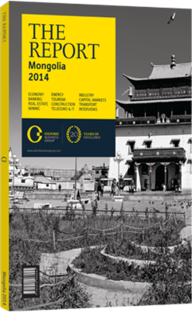Lending a hand: The authorities have been implementing a pro-growth policy
The Bank of Mongolia (BOM) pursued cautious and targeted monetary easing in 2013 in a bid to maintain macro stability, prevent credit crunch risk, and offset the impact of reduced exports and foreign direct investment. Amid benchmark interest rate cuts totalling 2.75 points in January (0.75), April (1) and June (1) to 10.5%, the BOM has used unconventional monetary policy instruments to pump MNT liquidity through the banking system toward key industries and the government bond market to stimulate aggregate demand.
Quantitative easing has come in three forms: a price stabilisation programme (PSP) aimed at preserving price stability in key goods in the short term; liquidity provided by the BOM to local banks to prevent credit crunch risk, avoid M2 contraction, and maintain broad money and credit growth; and a sustainable mortgage financing scheme aimed at increasing saving.
With BOM injections accounting for 21% of banking assets and 16% of GDP by August 2013, this policy has played a key role in maintaining double-digit real GDP growth and ensuring financial stability to safeguard the economy from a potential downturn.
PSP
A programme to stabilise prices of key products such as meat, flour and retail petrol, initiated by the BOM and the government in October 2012, channelled sub-market-interest-rate loans totalling $442m in 2013 through commercial banks to five key industries. Commercial banks are responsible for assessing credit risks and make decisions on lending independently.
The main recipient of PSP loans is construction, with $178m going to construction materials producers and importers. This was crucial in raising the supply of materials and contributing to increased growth in the sector. The second-largest recipient, importers of petrol and diesel fuel, was issued $115m. As a result, retail petrol prices have been quite stable, even though Russian export taxes on petroleum products have risen and the tugrik depreciated against the dollar by 19% in 2013. In addition, the volume of petroleum product stocks in Mongolia doubled, and the authorities’ bargaining power on Russian fuel prices has been enhanced. This enabled them to begin diversifying the source of petroleum imports by geographical location.
The two other main sectors covered by the PSP were meat and flour warehouse financing, to which banks issued $67m and $29m in loans in 2013, respectively, to temper price increases, reduce the impact of supply shocks on inflation and establish an efficient supply chain through financing the stocks of those key goods, with the inclusion of private sector. As a result, the meat price increase in 2013 was 4.2 times lower than in 2012 and 3.3 times lower than the average for 2010-12, and flour prices have been very stable, according to the National Statistical Office and the BOM.
Liquidity
From January 2013 the BOM provided direct liquidity support by depositing $540m to stabilise slowed credit growth and prevent a potential credit crunch. As a result, banking sector total credit growth recovered from 24% at the end of 2012 to 54% in December 2013. However, most of the credits were due to increases in mortgage and construction sector loans.
Sustainable Mortgage Financing Scheme
This new policy aims to boost household and middle class saving. The mortgage interest rate is 8%, plus or minus one percentage point, depending on the variance of inflation from its targeted level. The initial funding for refinancing existing mortgages and issuing new mortgage loans was provided by the BOM to commercial banks. However, those portfolios will be packaged as mortgage-backed securities issued by the Mongolian Mortgage Corporation and sold to the BOM, converted to Social Insurance Fund assets or offered to investors in the secondary market. In January 2014, $284m in existing mortgages were refinanced at an average of 8%, while $458m in new 8% mortgages were issued, and the securitisation process is being started. The authorities expect this programme to help the country transition from a consumption-based economy into a savings-based one, so it should be beneficial in keeping inflation low and stable in the long term.
You have reached the limit of premium articles you can view for free.
Choose from the options below to purchase print or digital editions of our Reports. You can also purchase a website subscription giving you unlimited access to all of our Reports online for 12 months.
If you have already purchased this Report or have a website subscription, please login to continue.

